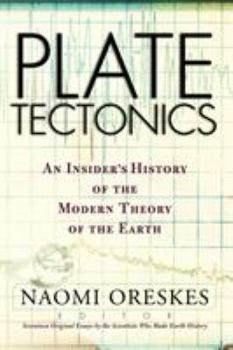Plate Tectonics: An Insider's History Of The Modern Theory Of The Earth
Select Format
Select Condition 
Book Overview
This book provides an overview of the history of plate tectonics, including in-context definitions of the key terms. It explains how the forerunners of the theory and how scientists working at the key academic institutions competed and collaborated until the theory coalesced.
Format:Paperback
Language:English
ISBN:0813341329
ISBN13:9780813341323
Release Date:February 2003
Publisher:CRC Press
Length:450 Pages
Weight:1.40 lbs.
Dimensions:1.1" x 6.0" x 9.1"
Customer Reviews
4 ratings
Plate Techtonic
Published by Thriftbooks.com User , 14 years ago
I was thinking this was the real verison of the Book I had in Collage. It will do for now.
Plate Tectonics
Published by Thriftbooks.com User , 21 years ago
Plate Tectonics: An Insider's History of the Moden Theory of the Earth edited by Naomi Oreskes is a book about the movement of the land masses on the Earth and how the theory of plate tectonics came about. In the book there are seventeen original essays by the scientists who made earth history as they explain how placte tectonics works.Plate tectonics is a science that you'd think has been around for a long time, but in fact, not until 1968 has the theory, research, data collection and analysis came together. The movement of relatively static land masses was not a popular idea, especially in the oil industry, where they believed that tectonics was not a viable theory.This book takes us on a journey in history giving us a historical background of continental drift to plate tectonics. What I find extemely interesting about this book is the actual players in the development of the theory are represented here. Giving their accounts and insight into why things are as they are... explaining their thought processes in confirmation of the theory of plate tectonics.Each author gives a piece of the puzzle until there is enough evidence that a workable theory can be developed. These authors tell us in their own words, making for a compelling book about discovery. Also, the reader will find an overview of definitions of terms used throughout the book, this keeps the readers interest as you will not be overburdoned with terms you do not understnd.All in all, this is a very readable book as it explains the science of plate tectonics and the inter-relationship of this science to man's well-being on earth.
Delightful "insiders' history"
Published by Thriftbooks.com User , 22 years ago
This book will delight all historians of science. The indefatigable Naomi Oreskes, known for her excellent history of continental drift and plate tectonics, has assembled reminiscences by the surviving founders of plate tectonics theory. Dr. Oreskes deserves the highest praise for this. Alas, the senior figures such as Arthur Holmes and Harry Hess are no longer with us; the writers of these essays were graduate students in the critical early 1960s. Now elders themselves, they recall the excitement of coming on the scene just when all was breaking loose. Even the most sober number-crunchers manage to write with infectious enthusiasm. The theories are explained in a notably accessible fashion, and the varied intellectual currents of the time (and, in some essays, subsequent decades) are brought out. My one complaint--as a reader interested in the history of science--is that the writers don't say much about their personal lives. One suspects that some of them have no personal lives beyond number-crunching. Most, however, hint at or partially reveal rich and interesting backgrounds that clearly affected their thoughts. Only Peter Molnar does much more than hint, and, although he claims that one reader called his essay "unexpurgated," even he is rather reticent. Still, this volume is a gold mine, providing a very different look at one of the most "revolutionary" (in scare quotes) theoretical advances in the history of science. The consensus here seems to be that it was indeed a revolution, at least in the eyes of American graduate students of the 1960s, but not a Kuhnian revolution brought about by highly intellectualized "paradigm shifts" (Kuhn 1962); it was brought about by new field methods that brought floods of new data. These allowed the development of real mathematical models. One can only stand in awe of the amount of work this entailed. Several authors speak of working day and night, week after week, on data entry and computer jockeying. They managed this without any loss of enthusiasm--quite the reverse, apparently. Ah, youth.
Plate Tectonics as told by those that assembled the theory
Published by Thriftbooks.com User , 22 years ago
This is a highly informative account of both the ideas that led to the development of Plate Tectonic theory and the concepts of how the earth works. The book is engaging to read and is understandable to an audience at the level of Scientific American. I am using it as a required text in my course at Columbia University titled "Plate-tectonic theory and its geological corollaries". For those fascinated in how the human mind puts observations together to build ideas and then test them, this book is first rate. Each chapter is crafted by a different researcher describing his or her contribution to the over all theory. The reader encounters brilliant and original ideas discarded by peer review, scientists peeping over each other's shoulder, the rush to the goal line to publish first, competition for access to key data sets, a last minute conversion from the static earth perspective, and the thrill of exploration at sea. The authors presents a wonderful history in Chapter 1 of the intellectual passage from the first inkling of continental drift in the 16th century to the breakthrough in 1966-1968 of the full-blown theory of rigid lithosphere paving stones and narrow plate boundaries.




